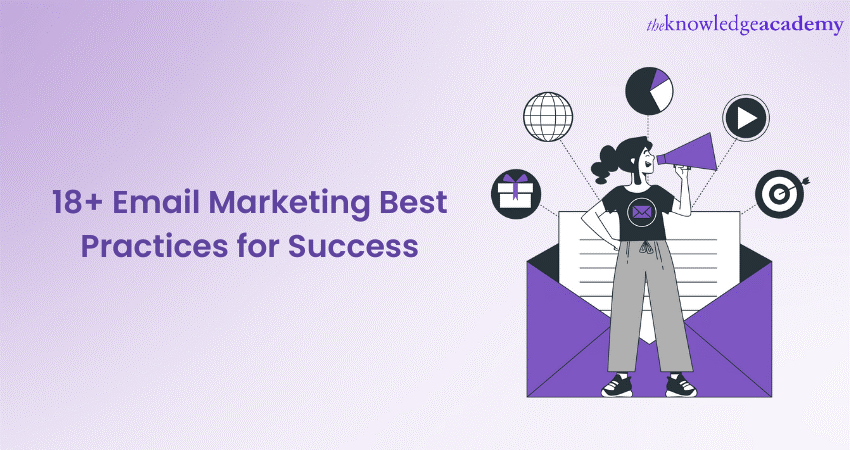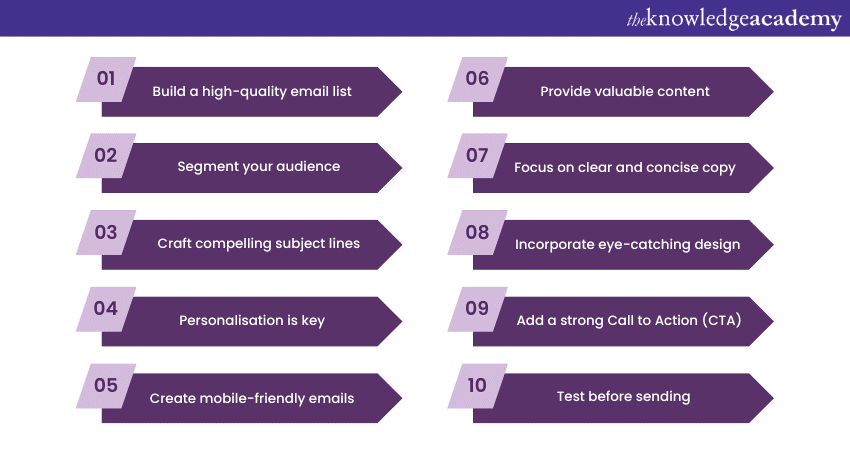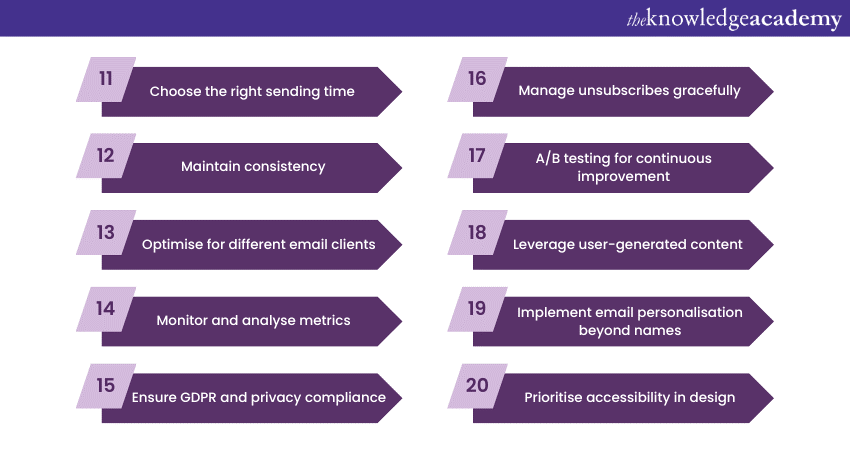We may not have the course you’re looking for. If you enquire or give us a call on +852 2592 5349 and speak to our training experts, we may still be able to help with your training requirements.
We ensure quality, budget-alignment, and timely delivery by our expert instructors.

In the domain of modern business, Email Marketing remains a potent instrument for nurturing customer relationships and driving conversions. Yet, achieving triumph in this arena demands a keen understanding of the most effective strategies. Therefore, it’s crucial to learn certain Email Marketing Best Practices. Want to know what these practices are and how Email Marketing Tips can help you improve your marketing strategies? This blog will present you with 18+ Email Marketing Best Practices that can propel your campaigns to greatness. Keep reading!
Table of Contents
1) Top Email Marketing Best Practices
a) Build a high-quality email list
b) Segment your audience
c) Craft compelling subject lines
d) Personalisation is key
e) Create mobile-friendly emails
f) Provide valuable content
g) Focus on clear and concise copy
h) Incorporate eye-catching design
i) Add a strong Call to Action (CTA)
j) Test before sending
2) Conclusion
Top Email Marketing Best Practices
Let's delve into the top Best Practices for Email Marketing you can implement to ensure your marketing campaigns’ success.

1) Build a high-quality email list
A high-quality email list is the cornerstone of successful Email Marketing. It comprises individuals genuinely interested in your brand. Building such a list takes time and effort, but the results are worth it.
So, avoid shortcuts like purchasing lists, which can harm your reputation and deliverability. Instead, focus on capturing leads through opt-in forms on your website, social media, and events. This ensures that your emails reach engaged recipients who are more likely to open, click, and convert.
2) Segment your audience
Segmentation helps you tailor your email content to reach specific groups within your subscriber list. By understanding your audience's preferences, behaviours, and demographics, you can send targeted messages that connect with them on a deeper level.
From their purchase history, location, or interests, segmentation boosts open rates, click-through rates, and conversions. It demonstrates that you understand your subscribers' needs and are committed to delivering relevant content.
3) Craft compelling subject lines
Your subject line is your email's first impression and a decisive factor in whether it gets opened. To stand out in a crowded inbox, create subject lines that are intriguing, concise, and aligned with the email's content.
Therefore, incorporate curiosity, urgency, or personalisation to capture the recipient's attention. Avoid spammy language and excessive use of capital letters and symbols, as these can trigger spam filters. A well-crafted subject line sets the stage up for a successful Email campaign by enticing recipients to explore further.
4) Personalisation is key
Personalisation adds a human touch to your emails and fosters a stronger connection with your subscribers. Beyond addressing recipients by their names, use data to deliver content that resonates with their preferences and behaviours.
Moreover, leverage past interactions and purchase history to recommend products or services tailored to their interests. Personalised Emails make your subscribers feel valued and understood, increasing the likelihood of engagement and conversions.
5) Create mobile-friendly emails
With a large portion of emails being opened on mobile devices, mobile friendliness is non-negotiable. So, design responsive emails that adapt to different screen sizes, ensuring that your content remains visually appealing and easy to navigate. This is an essential Email Marketing Skills practice to improve user engagement and deliverability.
Further, use a single-column layout, larger fonts, and touch-friendly buttons. Also, preview and test your emails on various devices to ensure a seamless experience for all recipients, regardless of their device.
Elevate your Email Marketing skills with our expert-led Email Marketing Training – Sign up now!
6) Provide valuable content
Deliver content that enriches your subscribers' lives. From informative articles, how-to guides, or exclusive offers, your emails should provide value that keeps recipients engaged. Therefore, it’s crucial to understand your audience's pain points and aspirations and address them in your content. By positioning yourself as a source of knowledge and solutions, you build trust and credibility, making your subscribers likelier to engage with your Emails and take desired actions.
7) Focus on clear and concise copy
Keep your email content concise and easily digestible. In the fast-paced world of email, brevity is key. Therefore, craft concise yet compelling copy that gets your message across quickly. Use short paragraphs, bullet points, and subheadings to divide the text into smaller segments and make it easily scannable.
Moreover, eliminate unnecessary jargon and focus on delivering a clear, actionable message. While you're introducing a new product, sharing a blog post, or announcing a sale, your email should provide value and clarity without overwhelming the reader.
8) Incorporate eye-catching design
Visual appeal plays an essential role in capturing your recipients' attention. Design your Emails with a consistent and visually appealing layout that aligns with your brand identity. Further, use colours, images, and typography that resonate with your audience and enhance readability.
Also, ensure that your design guides the reader's eye towards the most important elements, such as your call to action (CTA). A well-designed Email not only enhances the user experience but also reinforces your brand's professionalism and credibility.
9) Add a strong Call to Action (CTA)
Your email's purpose is to guide the recipient towards a specific action, from making a purchase, registering for a webinar, or downloading a specific resource. Your CTA should be clear, action-oriented, and placed prominently within the email.
Thus, use action verbs that convey urgency or benefit, such as "Shop Now," "Get Started," or "Claim Your Discount." Also, employ contrasting colours and ensure that your CTA stands out visually. By making it easy for recipients to take the desired action, you increase the chances of conversions.
10) Test before sending
Before you hit the send button, thorough testing is essential. Preview your email across different devices, email clients, and web browsers to ensure consistent rendering. Also, check for any broken links, formatting issues, or typos that might diminish the user experience.
Sending test emails to yourself and colleagues can help catch any last-minute errors before the email reaches your subscribers' inboxes. Testing guarantees that your email looks and functions as intended, maintaining a professional image and optimal engagement.

11) Choose the right sending time
The timing of your emails can largely impact their effectiveness. Thus, make sure to experiment with sending emails at different times and days to determine when your audience is most receptive.
Moreover, consider factors like time zones, industry norms, and your subscribers' routines. Analytics tools can provide insights into when your Emails are most often opened and engaged with. Tailoring your sending times to match your audience's habits increases the likelihood that your Emails will be seen and acted upon.
12) Maintain consistency
Consistency builds trust and recognition. Establish a regular sending schedule that aligns with your audience's expectations. From weekly newsletters, monthly updates, or special promotions, sticking to a consistent cadence keeps your brand top-of-mind and avoids overwhelming your subscribers. Use an Email Marketing calendar to plan and schedule your campaigns, ensuring that you're delivering valuable content consistently over time.
13) Optimise for different email clients
Email clients vary in how they display emails, and ensuring compatibility across platforms is crucial. Thus, design your emails using responsive templates that adapt to different screen sizes and orientations.
Further, test your emails on popular email clients like Gmail, Outlook, and Apple Mail to ensure consistent rendering. Pay attention to how images, fonts, and formatting appear on each platform. By optimising for different email clients, you guarantee that your message reaches recipients in the intended format, enhancing the user experience.
14) Monitor and analyse metrics
Effective Email Marketing relies on data-driven decision-making. By leveraging Email Marketing Analytics, make sure to monitor key metrics such as open rates, click-through rates, conversion rates, and unsubscribe rates. Analytics tools provide insights into subscriber engagement and behaviour, helping you refine your strategies.
Further, identify trends, patterns, and areas for improvement. A/B testing different elements, subject lines, and content can provide insights into what resonates best with your audience. Regularly reviewing metrics empowers you to make informed adjustments for more successful campaigns.
15) Ensure GDPR and privacy compliance
Respecting data privacy laws is paramount. If you're sending emails to subscribers in the UK or the EU, ensure compliance with the General Data Protection Regulation (GDPR). Obtain proper consent before sending marketing Emails and provide a clear and easy way for recipients to opt-out or unsubscribe.
Also, include a privacy policy that describes how you collect, use, and protect subscriber data. By prioritising privacy compliance, you build trust with your audience and demonstrate your commitment to ethical Email Marketing practices.
Elevate your Email Marketing skills with our Digital Email Marketing Masterclass – Join now to embark on a journey towards unrivalled success!
16) Manage unsubscribes gracefully
Unsubscribes are an unavoidable part of Email Marketing and should be handled gracefully. So, include a visible and easily accessible unsubscribe link in your emails. When recipients choose to unsubscribe, honour their decision promptly.
Additionally, provide a brief confirmation message acknowledging their request and assuring them that they've successfully unsubscribed. Avoid any friction or confusion during this process, as a positive experience, even when leaving your email list, can leave a lasting impression of professionalism.
17) A/B testing for continuous improvement
Continuous improvement is at the heart of successful Email Marketing. Make use of A/B testing (also known as split testing) to experiment with different variations of your emails. Test elements such as subject lines, CTAs, images, and content to identify what connects best with your audience.
Further, analyse the results to make informed decisions about which strategies are most effective. A/B testing helps you fine-tune your campaigns over time, ensuring that you're always learning, adapting, and optimising for better results.
18) Leverage user-generated content
Harness the power of your engaged audience by incorporating User-generated Content (UGC) into your Email Marketing strategy. UGC includes photos, reviews, testimonials, and other content created by your customers. Sharing UGC in your emails not only provides social proof but also encourages a sense of community among your subscribers.
Feature customer testimonials or reviews in your emails to showcase real experiences and build trust. Moreover, run UGC campaigns, asking customers to share their stories or use your products in creative ways, and then spotlight the best submissions in your Emails.
By involving your audience in your email content, you foster a deeper connection, increase engagement, and humanise your brand. Just ensure you have proper permissions to use the UGC and give credit where it's due.
19) Implement email personalisation beyond names
While addressing recipients by their names is a well-known personalisation tactic, modern Email Marketing goes beyond this basic approach. Leveraging the wealth of data available, you can create highly personalised email experiences.
So, draw insights from past interactions, purchase behaviour, website visits, and preferences to craft content that speaks directly to each subscriber's interests and needs. Incorporating dynamic content blocks allows you to present different product recommendations or content sections based on individual user profiles. This level of personalisation shows that your emails are not just generic messages but valuable resources crafted uniquely for each recipient. Ultimately, going the extra mile with personalisation results in higher engagement, improved customer satisfaction, and a significant boost in overall Email Marketing effectiveness.
20) Prioritise accessibility in design
Designing emails with accessibility in mind is both a responsible and strategic choice. Accessibility makes sure that everyone, including people with disabilities, can engage with your Email content seamlessly. To achieve this, start by selecting clear, legible fonts and maintaining a suitable font size that's easy to read. Pay attention to colour contrasts to ensure that text remains discernible against the background.
By prioritising accessibility, you demonstrate your commitment to inclusivity and equal access to information. Beyond the ethical imperative, accessible emails also contribute to better engagement and deliverability.
Many spam filters consider accessibility factors as indicators of legitimate emails, potentially improving your deliverability rates. As accessibility gains traction in digital spaces, embracing it in your email design not only adheres to legal requirements but also aligns with the values of a socially responsible brand.
Conclusion
By adhering to the aforementioned Email Marketing Best Practices, you can create campaigns that resonate with your audience, deliver genuine value, and pave the way for lasting success. The choice of Email Marketing Software can significantly impact the success of your email marketing campaigns. Selecting a platform that aligns with your specific needs and budget is crucial for maximizing your return on investment. Make sure to stay informed, adapt to evolving trends, and keep refining your approach to ensure your Email Marketing efforts yield the desired impact.
Gain an understanding of developing effective Digital Marketing strategies with our Digital Marketing Training. Sign up today!
Frequently Asked Questions
Upcoming Digital Marketing Resources Batches & Dates
Date
 Email Marketing Course
Email Marketing Course
Fri 7th Mar 2025
Fri 23rd May 2025
Fri 18th Jul 2025
Fri 12th Sep 2025
Fri 14th Nov 2025
Fri 12th Dec 2025






 Top Rated Course
Top Rated Course



 If you wish to make any changes to your course, please
If you wish to make any changes to your course, please


